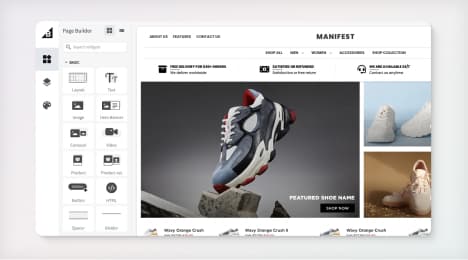
Watch Our Product Tour
See how BigCommerce helps you build and manage your online store with ease.
- Ecommerce Insights

6 Key Steps to Launch Your Online Store
Explore our Launch Foundations series to get your BigCommerce store up and running quickly.
BigCommerce helps growing businesses, enterprise brands, and everything in-between sell more online.
What is Ecommerce ERP?
Whether you’re a business-to-business (B2B), business-to-consumer (B2C), or direct-to-consumer (D2C) ecommerce retailer, you have one goal: to grow your business. However, as your business grows, so too does the complexity of your operations. Where once QuickBooks could handle your accounting, Salesforce could handle your customer relationship management (CRM), and SkuVault could handle your inventory management, you now require more than these disconnected, siloed solutions can provide.
Enter ecommerce ERP (Enterprise Resource Planning), the seamless integration of your ecommerce system with a modern, cloud-based ERP solution. Together, they extend your organization’s breadth and depth, connecting your processes and procedures for a cohesive, future-proofed operation.
Basics of an ERP and ecommerce Integration
To understand how an ERP and ecommerce integration works, you must first start with ecommerce logistics, which includes taking and fulfilling orders, processing payments, handling returns, managing inventory, ensuring security, calculating taxes, tracking financials, and providing customer support. These become harder to juggle when your small operation (perhaps you started in your garage) morphs into a full-fledged operation with a warehouse—or two, or three—a shipping fleet, and multiple employees.
Relying on systems that have been cobbled together, making them function by sheer determination and willpower, will no longer work. Everyone will suffer from a lack of data, consistency, and control. Thankfully, you can integrate your ecommerce software solutions with a modern ERP, automating your current procedures and processes (a.k.a becoming more efficient), and successfully avoiding additional data challenges in the future.
There are a few ways to integrate ERP and modern ecommerce solutions. You can utilize the ecommerce solution’s API on your own, which gives you complete customization, but it also leaves you completely responsible for managing the integration. You can utilize a third-party solution with a pre-built integration using the API, which is relatively easy to work with and can often be used “out of the box”—although if you need any personalization, you will pay for and rely on the third-party team without a guarantee that you’ll get what you want or need.
Or you can utilize an ERP system with a native ecommerce integration. An ERP with native integration, such as the Acumatica-BigCommerce Connector, is arguably the most flexible and future-proof option. The ERP company is the builder of the native integration to the ecommerce system, exposing as much of the ERP as the API is willing to accept. When “crazy” business scenarios arise (and they will), the integration is then agile enough to meet the marketplace’s ever-changing needs.
What ERP Features are Important for Ecommerce Businesses?
When your ecommerce business is ready to integrate your ecommerce platform with an ERP solution, there are a few key features that must be included within your ERP search criteria.
1. Finance.
Though your general ledger (GL), accounts payable (AP), and accounts receivable (AR) can be managed through QuickBooks, a cloud ERP solution allows you to manage those tasks while also supplying real-time ecommerce updates. For example, when an ecommerce site sale comes into your ERP solution, it immediately shows up in the sales order and is populated throughout your financial statements. As soon as the payment goes through, it’s seen as revenue.
It’s also important to note that venture capital and bank loans of significant size are typically not granted to rapidly growing organizations using small business accounting software like Quickbooks. They know that an export from QuickBooks can be manipulated. With an ERP system, documentation is set in stone, and the information is 100% accurate.
Additionally, an ERP system audits your finances, your inventory, your customers (including relationships and opportunities), and your sales. By integrating your ecommerce platform with ERP, the ecommerce system becomes an extension of that auditing system.
2. CRM.
CRM within ERP that integrates with your ecommerce solution is a win-win-win situation. Why?
A successful ecommerce business must have an effective, standardized way to manage leads, contacts, opportunities, and customer accounts as well as the ability to know what’s happening during each step of the sales cycle. In other words, you need a seamlessly integrated CRM solution, which gives every department access to real-time, synchronized data from a single source.
Building a customer database within the integrated solutions allows you to easily reach out to your customers with offers such as sales, discounts, and special promotions; these promotions are designed inside the ecommerce platform and the ERP system understands what it’s receiving, making a record for later reporting.
Additionally, ecommerce ERP and CRM integration create an omnichannel commerce environment. Regardless of how customers purchase your product from you, your centralized CRM will associate each order with the correct customer. It provides a 365-degree view of how your customers have engaged with you in the past and how they’re engaging with you in the present.
3. Inventory management.
When business is booming, tracking inventory becomes more complicated. You need to know where your products are located, and your customers want to know if the product is in stock. An integrated ERP solution is smart enough to communicate this information to everyone. It offers accurate, real-time access to available inventory, whether the inventory is located in a warehouse, split between warehouses, or in transit. You’re also privy to reorder quantities and inventory costs.
Logging into multiple systems to find the answer is no longer a requirement, the process is automated, and manual errors are reduced (or eliminated).
4. Shipping, distribution, and warehouse management.
As with inventory management, an integrated ecommerce ERP solution is the most accurate and efficient method for managing your shipping, distribution, and warehouse management needs.
The distribution process is multifaceted, including wave and batch picking, packaging, PO receiving, putting away, transferring, and physical counting. With ERP, these tasks become automated. Warehouse workers can use phones or tablets to perform their tasks, lot and serial number tracking eliminates mistakes, and EDI compliance is handled by third-party EDI software.
5. Product information management.
Because you sell products to customers in different ways, centralizing your product information within an ecommerce ERP solution is critical. This information could be about your vendors, product pricing, and customer-specific pricing, or perhaps options associated with your product. Managing your information in one location allows you to push that information out to many locations.
Essentially, you have a content management system. For example, if you sell on multiple websites, it allows you to distinguish between audiences and disseminate the information appropriate to each audience.
Top Advantages of Integrating Your Ecommerce and ERP
Selecting an ERP solution based on the features listed above affords you many advantages, including a better online experience, pricing management, access to valuable data, increased productivity, and process visibility.
Better online experiences.
The better online experience for your customers comes from the improved level of customer engagement. For example, the ERP solution manages your fulfillment and can notify customers when the manufacturing process begins, when the product is boxed up, and when the item is shipped out.
2. Pricing management.
Pricing management, like product information management, is the ability to manage your product pricing within ERP. You can customize your response to different customers. For example, in B2B, if customer number one has negotiated rates and customer number two, a new customer, has not, you can push the correct information out to the ecommerce platform accordingly. You can also determine the access rights of individual customers to your product (e.g., customer one has 100% access and customer two has 80%).
3. Access to valuable data.
Speaking of access, you will have access to valuable data being pulled in real time from the ecommerce site where the information has been stored as customers engage with you. This data is used for actionable reporting and forecasting.
4. Process visibility.
This leads to process visibility. Simply put, you can generate reports that show you how your company, sales, returns, and inventory are doing. You also can see who is doing what and assess the profitability of your business.
5. Increased productivity.
Finally, increased productivity results when every employee uses the ERP system as the centralized system of record. Automating their tasks, such as automatically tracking inventory deductions during fulfillment or generating an automated process for a purchase order request, increases productivity even further.
Conclusion
Ecommerce ERP may be the answer for any ecommerce business that is looking to grow. The seamless integration of your ecommerce system with a modern, cloud-based ERP solution allows you to connect your processes, procedures, and data, producing an efficient, profitable business.
This blog post was contributed by Josh Fischer, Product Manager, Acumatica.
BigCommerce helps growing businesses, enterprise brands, and everything in-between sell more online.
Start growing your ecommerce business even faster.
High-volume or established business? Request a demo